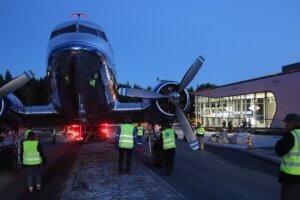Our collection focuses on Finnish aviation, including aircraft designed or used by Finns and their role in both domestic and international aviation. The collection also includes photographs, documents, and books, which are of national importance for preserving aviation history.
Collections
Collections
The most significant objects in the museum are 82 aircraft. Highlights of the aircraft collection include:
The Consolidated-Vultee Convair 340/440 Metropolitan airliner from 1953
The I.V.L. A22 Hansa maritime reconnaissance aircraft from 1922
A Messerschmitt Bf 109G-2 wreck
The collection also includes hang gliders from the 1970s and a hot air balloon envelope with basket made by Finnish designer Veikko Kaseva. Other large and important objects include 29 engines and 14 cockpit devices.
The museum’s collection contains about 10,000 objects, approximately 285,000 photographs, and around 1,500 shelf meters of archival material. Photographs are the largest part of the collection. The museum has already made 9,785 photographs available to the public through the Finna database. You can explore the diverse collections on the museum’s website and in Finna.
The collections are one of the museum’s strongest and most impressive attractions. The collection program is a living tool for the museum. It sets the goals, principles, and methods for managing and using the collections. Explore the Finnish Aviation Museum’s Collection Policy for 2025–2029. The document is written in Finnish.
Ways to support

Support Convair Metropolitan
The Convair 440 Metropolitan OH-LRB at the Aviation Museum has the longest service history in Finnair’s history. It carried passengers and cargo for 27 years. Finnish airlines Finnair and Kar-Air operated a total of nine Convair aircraft from the 1950s to the 1980s. Even today, Convairs are still flying as cargo planes around the world. The plane’s narrow aisle gives visitors a feeling of the relaxed travel of the past.
You can help preserve and move the Convair to the New Aviation Museum by donating to the museum’s collection fund. The funds are used, for example, for moving costs and modern air cushions to protect the aircraft.

Support aviation’s reliable hero
The Lockheed 18-07 Lodestar OH-VKU is a passenger aircraft equipped with two piston engines. The Aviation Museum’s Lockheed Lodestar flew passenger flights for the Finnish Kar-Air Oy in the 1950s. The aircraft served in geological survey and mineral exploration tasks for the Geological Survey of Finland until the 1970s. Scientific antennas and communication devices related to the Lodestar’s mineral exploration are preserved in the museum collections.
You can support the preservation and transfer of the aircraft to the New Aviation Museum by donating to the museum’s collection fundraising. The collection fundraising is directed towards, among other things, the transfer costs of the Lockheed Lodestar and the acquisition of transfer equipment.

Support the conservation of the iconic Messerschmitt
The Messerschmitt Bf 109 G-2 on display in the basic exhibition of the Finnish Aviation Museum is a single-seat German fighter aircraft, manufactured in Austria, and was one of the main fighter aircraft of the German Air Force, Luftwaffe, during World War II.
Over 150 Messerschmitt aircraft were acquired by Finland during the war, and for example, the museum’s Bf 109 G-2 received the designation MT 208 according to the Finnish Air Force. MT-208 made an emergency landing in the sea off the coast of Pori in the 1940s and was only raised for museum purposes in 1999. After being in the sea for 53 years, the Messerschmitt had broken into pieces, and for example, the aircraft’s engine, propeller, rudder, cockpit, and wings had to be raised separately.
Communication devices and cabin crew uniforms
Parts of the cabin and cockpits, interior parts, propellers, and communication devices also form a significant part of the museum collection. Communication devices include large air traffic control equipment and interior parts, runway lights, radars, and flight beacons. The collection of airline uniforms and early aviation equipment is also extensive and significant.
Moving and preserving all 10,000 objects and other substantial materials of the Aviation Museum in appropriate conditions is a massive task. Join us in supporting the transfer of the collection’s gems and your favorite items towards the New Aviation Museum!
Photo: DC-3 aircraft “Lokki” (OH-LCD) in the capable hands of volunteers during the move, on its way to becoming a landmark in the Aviation Museum’s yard.

Support the transfer of collections towards the New Aviation Museum!
Let’s ensure the transfer and preservation of 10,000 collection items and all materials in the New Aviation Museum.